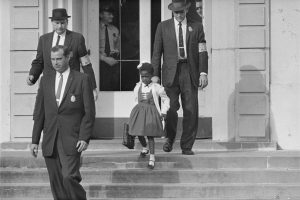LeRhonda S. Manigault-Bryan in The New York Times:
 April 13, 1947, holds little significance in the American historical memory, and yet that day was one in a long series that led to the legal desegregation of American schools. On that morning, Marguerite Daisy Carr, a 14-year-old black girl from Washington, D.C., attempted to enroll at Eliot Junior High School, the all-white middle school closest to her home. Carr’s efforts to integrate the school, which were supported by her family and local black community, preceded the landmark Supreme Court decision in Brown v. Board of Education by seven years.
April 13, 1947, holds little significance in the American historical memory, and yet that day was one in a long series that led to the legal desegregation of American schools. On that morning, Marguerite Daisy Carr, a 14-year-old black girl from Washington, D.C., attempted to enroll at Eliot Junior High School, the all-white middle school closest to her home. Carr’s efforts to integrate the school, which were supported by her family and local black community, preceded the landmark Supreme Court decision in Brown v. Board of Education by seven years.
Recognizing the young black girls and women who were at the forefront of the civil rights movement is the central achievement of Rachel Devlin’s meticulously researched history, “A Girl Stands at the Door.” Devlin’s interest in the role such women played in the struggle for desegregation leads her briefly back to 1850, to Sarah Roberts, a 5-year-old African-American who lived closer to several white schools than to the one designated for black students, and who became a plaintiff in the country’s first school desegregation case: Roberts v. City of Boston. The Massachusetts Supreme Judicial Court ruled in favor of Boston, which resisted the desegregation effort on the grounds that adequate provisions had been made for black students in the form of separate schools. Roberts’s case was later cited to support the “separate but equal” ruling in Plessy v. Ferguson, but it also shed public light on the underfunding and inadequate conditions prevalent in black schools — conditions that endured, virtually unchanged, for another 120 years. Devlin’s account is necessarily situated largely in the 20th century and includes the stories of Ruby Bridges and Melba Pattillo Beals (one of the “Little Rock Nine”), among many others; she reveals the creative tactics these young people used — sometimes successfully, sometimes not — to integrate public schools, a battle in which black girls outnumbered black boys as plaintiffs two to one.
More here.
